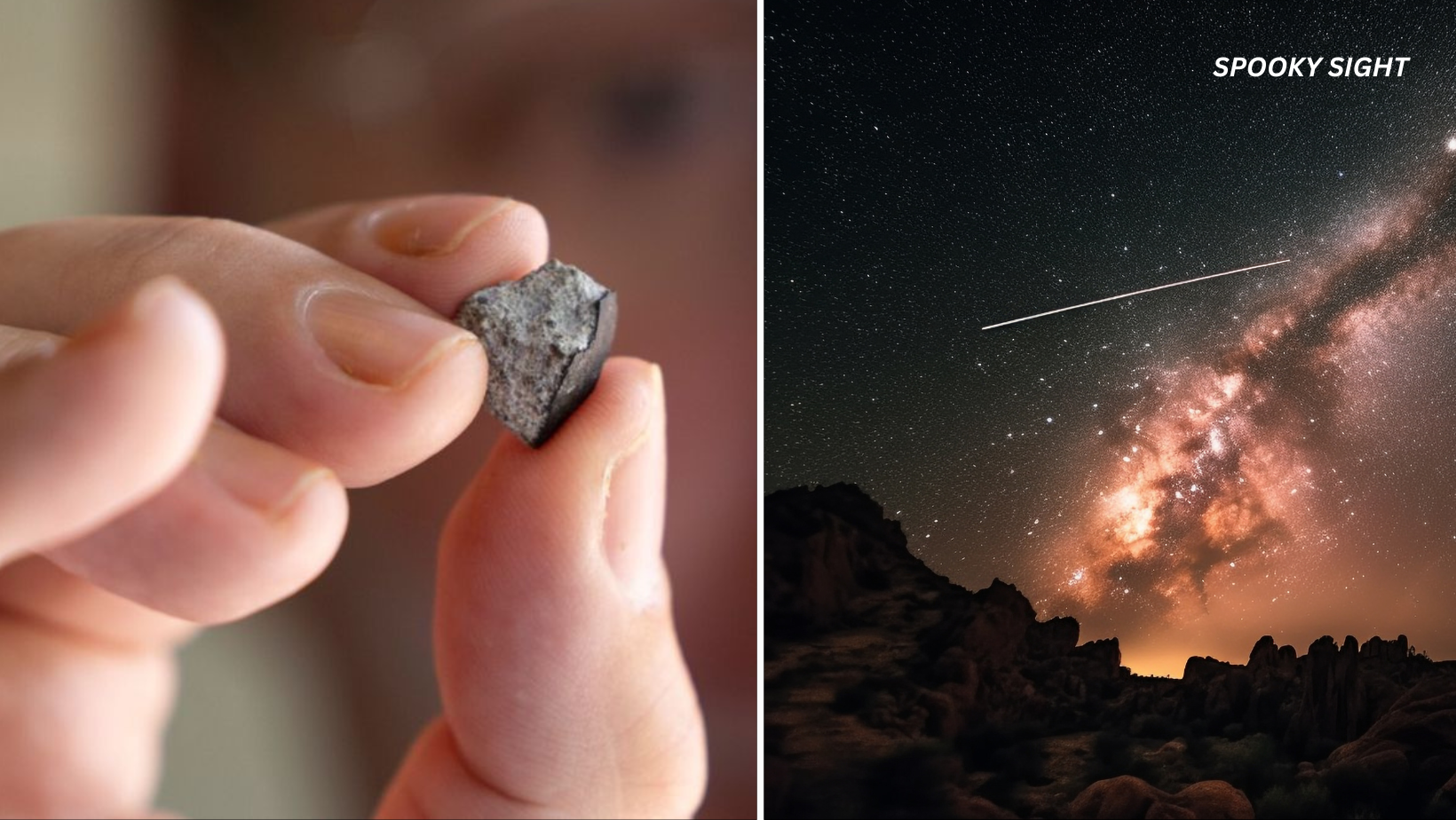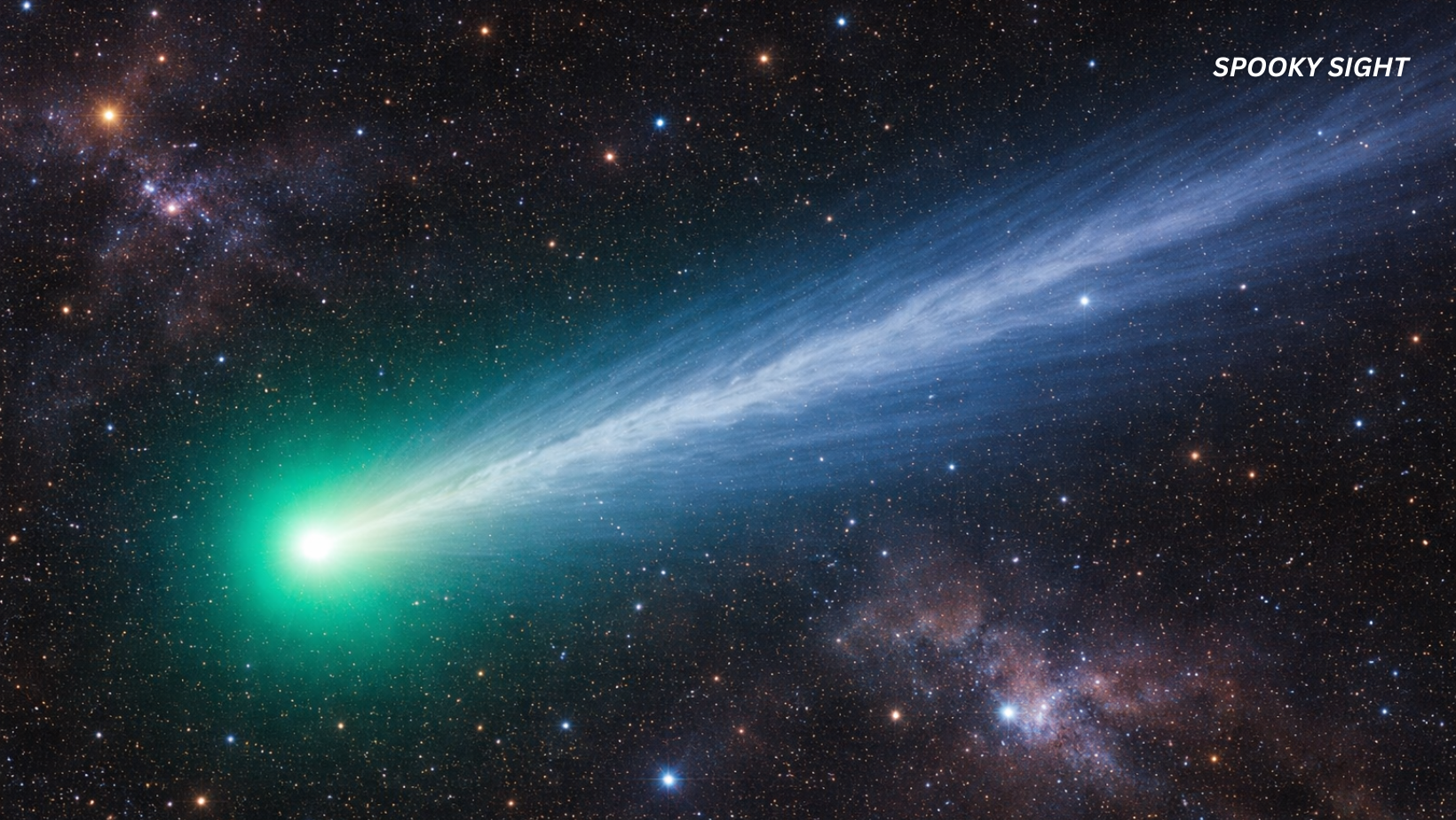On a sunny afternoon in late July, the peaceful routine of McDonough, Georgia, was shattered—quite literally—by an unexpected guest from deep space. Without warning, a blazing streak of light cut across the sky, bright enough to be seen in broad daylight. To anyone looking up, it was spectacular. To the owner of one particular home, it was a different story: moments later, the cosmic intruder smashed through their roof, broke through the ceiling, and cracked the floor—landing just 14 feet (about 4 meters) from a startled resident.
This was no ordinary falling object. According to researchers, the rock in question is possibly older than Earth itself. Which means, in a way, a tiny fragment of the solar system’s earliest days has just been delivered to a Georgia living room.
The Sky Lights Up
The date was July 26. Residents across several southeastern U.S. states noticed an unusually bright fireball streaking through the sky. “Fireball” is the term scientists use for meteors that shine brighter than Venus, the second-brightest object in our night sky. Seeing one in broad daylight is rare—so rare, in fact, that it’s usually a once-in-a-lifetime event for any given location.
The spectacle wasn’t just caught by human eyes. A satellite orbiting Earth detected the flash, confirming that something sizable had entered the atmosphere at high speed. But instead of burning away completely like most meteors, this one managed to survive the fiery plunge.
Read more: 40 Years Later, Terminator Finally Explains Why Skynet Wants To Get Rid Of Humanity
From Outer Space to the Kitchen Table
The surviving piece weighed in at about 23 grams—roughly the weight of a large strawberry or a stack of five U.S. quarters. Scientists collected the fragments and brought them to the University of Georgia (UGA) for analysis.
Scott Harris, a geologist at UGA, likens studying a meteorite to “reading the oldest book in the library—except the pages are made of minerals, and you have to figure out the language before you can read it.”
What the Rock Revealed
Early analysis showed that the McDonough Meteorite is a Low Metal Ordinary Chondrite. This classification is important:
- “Chondrite” means it contains chondrules—tiny, round grains formed from molten droplets in the early solar system.
- “Ordinary” refers to it being one of the most common types of meteorites found on Earth.
- “Low Metal” means it has less iron and nickel than some other meteorites.
These features suggest the rock formed about 4.56 billion years ago—slightly older than Earth, which is about 4.54 billion years old. This means it has been traveling the cosmos since before our planet even existed.
How Scientists Figure Out a Meteorite’s Age
Dating a meteorite isn’t as simple as checking a calendar. Scientists rely on a process called radiometric dating. Here’s how it works in simple terms:
- Radioactive Clocks – Some elements in the meteorite are unstable and naturally break down into other elements over time. This happens at a predictable rate, like sand falling in an hourglass.
- Measuring the Ratio – By comparing how much of the “parent” element remains versus how much “daughter” element has formed, scientists can calculate how long the process has been going on.
- A Window Into the Past – Because meteorites often remain unchanged since they first formed, these measurements can reveal their age with remarkable precision.
Read more: Doctors Horrified After Google’s Healthcare AI Makes Up Nonexistent Human Body Part
A Violent Origin Story
Where did this particular rock come from? Evidence points to the asteroid belt between Mars and Jupiter. Around 470 million years ago, a catastrophic collision broke apart a much larger asteroid in that region. The McDonough meteorite likely began its journey as a chunk of that shattered body.
Over millions of years, gravitational nudges from planets—especially Jupiter—altered its orbit until it eventually crossed Earth’s path. Its trip through space may have taken it past Mars, into the inner solar system, and possibly close to Earth more than once before finally meeting our atmosphere head-on.
The Fiery Final Descent
As it plunged toward Earth, the meteorite hit the atmosphere at tens of thousands of miles per hour. The sudden pressure and friction created temperatures so high that its outer surface began to melt and vaporize. This produced the brilliant fireball witnessed by so many people.
The intense heat also formed a thin, dark layer called a fusion crust—a kind of charred coating that acts as a badge of survival. Inside, however, the meteorite remained unchanged, still carrying the ancient minerals it had preserved for billions of years.
Why Chondrites Are Treasured by Scientists
Chondrites are among the most scientifically valuable meteorites because they’re essentially time capsules from the early solar system. Unlike rocks on Earth, which have been altered by weather, erosion, and plate tectonics, chondrites have remained chemically and structurally intact since they first formed.
By studying them, scientists can learn:
- What materials built the planets – Chondrites contain the same minerals that once swirled in the solar system’s “protoplanetary disk.”
- Whether water and organic molecules existed early on – Some meteorites contain traces of these building blocks of life.
- How the solar system evolved – The mineral mix and isotope ratios in a meteorite can reveal where and how it formed.
From Living Room Curiosity to Museum Exhibit
Scott Harris and his team are working on a detailed study of the McDonough Meteorite, which will outline its composition, likely origin, and the path it took through space. Once their research is complete, fragments will be displayed at the Tellus Science Museum in Cartersville, Georgia.
There, visitors will have the rare chance to stand inches away from a rock that’s older than Earth, forged at a time when the Sun was young and the planets were still forming.
Why This Matters
While small meteors hit Earth’s atmosphere every day, most are too tiny to survive the trip to the ground. Even fewer land in areas where they can be recovered and studied.
The McDonough Meteorite’s survival—and its dramatic arrival in a populated area—makes it an especially valuable find. It’s not just a souvenir from space; it’s a scientific messenger carrying information from a time long before humans, dinosaurs, or even Earth itself.
Read more: The Butterfly Effect Is Real—But Science Says It Works Differently Than You Think
A Cosmic Perspective
Events like this remind us that we live on a planet traveling through a busy cosmic neighborhood. Every so often, a fragment of that larger universe pays us a visit, forcing us to look up from our routines and consider the incomprehensible span of time and space that surrounds us.
In the end, the McDonough Meteorite is more than just a broken roof and a cracked floor—it’s a tangible connection to the birth of our solar system, a small but profound reminder that while we may feel grounded here on Earth, we are all part of something far bigger and much, much older.
Image credit: University of Georgia/Freepik ai.









